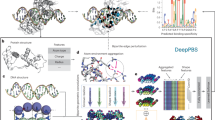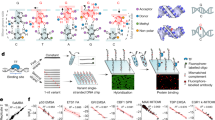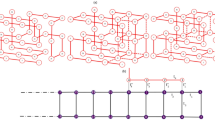Abstract
IN recent years the capacity of proteins to bend DNA by binding to specific sites has become a widely appreciated phenomenon1–7. In many cases, the protein-DNA interaction is known to be functionally significant because destruction of the DNA site or the protein itself results in an altered phenotype. An important question to be answered in these cases is whether bending of DNA is important per se or is merely a consequence of the way a particular protein binds to DNA. Here we report direct evidence from the bacteriophage lambda integration system that a bend introduced by a protein is intrinsically important. We find that a binding site for a specific recombination protein known to bend DNA can be successfully replaced by two other modules that also bend DNA; related modules that fail to bend DNA are ineffective.
This is a preview of subscription content, access via your institution
Access options
Subscribe to this journal
Receive 51 print issues and online access
$199.00 per year
only $3.90 per issue
Buy this article
- Purchase on SpringerLink
- Instant access to full article PDF
Prices may be subject to local taxes which are calculated during checkout
Similar content being viewed by others
References
Wu, H.-M. & Crothers, D. M. Nature 308, 509–513 (1984).
Zahn, K. & Blattner, F. R. EMBO J. 4, 3605–3616 (1985).
Mukherjee, S., Patel, I. & Bastia, D. Cell 43, 189–197 (1985).
Shuey, D. J. & Parker, C. S. Nature 323, 459–461 (1986).
Hatfull, G. F., Noble, S. M. & Grindley, N. D. F. Cell 49, 103–110 (1987).
Vignais, M.-L. & Sentenac, A. J. biol. Chem. 264, 8463–8466 (1989).
Zwieb, C., Kim, J., & Adhya, S. Genes Dev. 3, 606–611 (1989).
Craig, N. L. A. Rev. Genet. 22, 77–105 (1988).
Gardner, J. F. & Nash, H. A. J. molec. Biol. 191, 181–189 (1986).
Robertson, C. A. & Nash, H. A. J. biol. Chem. 263, 3554–3557 (1988).
Thompson, J. F. & Landy, A. Nucleic Acids Res. 16, 9687–9705 (1988).
Echols, H. Science 233, 1050–1056 (1986).
Richet, E., Abcarian, P. & Nash, H. A. Cell 46, 1011–1021 (1986).
Kosturko, L. D., Daub, E. & Murialdo, H. Nucleic Acids Res. 17, 317–334 (1989).
Liu-Johnson, H.-N., Gartenberg, M. R. & Crothers, D. M. Cell 47, 995–1005 (1986).
Koo, H.-S. & Crothers, D. M. Proc. natn. Acad. Sci. U.S.A. 85, 1763–1767 (1988).
Gamas, P., Chandler, M. G., Prentki, P. & Galas, D. J. J. molec. Biol. 195, 261–272 (1987).
Hübner, P., Haffter, P., lida, S. & Arber, W. J. molec. Biol. 205, 493–500 (1989).
de Vargas, L. M., Kim, S. & Landy, A. Science 244, 1457–1461 (1989).
Stenzel, T. T., Patel, P. & Bastia, D. Cell 49, 709–717 (1987).
Taylor, L. A. & Rose, R. E. Nucleic Acids Res. 16, 358 (1988).
Kitts, P. A. & Nash, H. A. J. molec. Biol. 204, 95–107 (1988).
Author information
Authors and Affiliations
Rights and permissions
About this article
Cite this article
Goodman, S., Nash, H. Functional replacement of a protein-induced bend in a DNA recombination site. Nature 341, 251–254 (1989). https://doi.org/10.1038/341251a0
Received:
Accepted:
Issue date:
DOI: https://doi.org/10.1038/341251a0
This article is cited by
-
Understanding the physics of DNA using nanoscale single-molecule manipulation
Frontiers of Physics (2012)
-
Biofilms can be dispersed by focusing the immune system on a common family of bacterial nucleoid-associated proteins
Mucosal Immunology (2011)
-
Ten years of tension: single-molecule DNA mechanics
Nature (2003)



